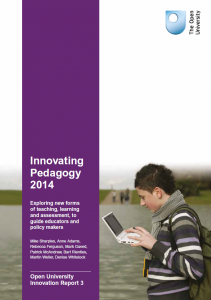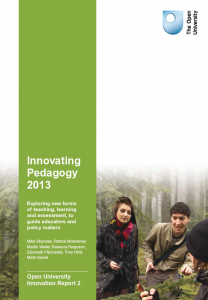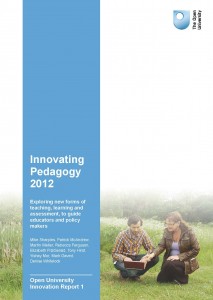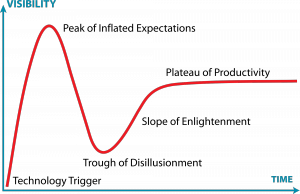
In November The OU released their latest Innovation Report – Innovating Pedagogy 2014. In this post we’ll take a look at the ten innovations in this latest addition, and also look back at the proposed innovations from previous editions of the report.
This series of reports explores new forms of teaching, learning and assessment for an interactive world, to guide teachers and policy makers in productive innovation. This third report proposes ten innovations that are already in currency but have not yet had a profound influence on education:
1. Massive open social learning
Massive open social learning brings the benefits of social networks to the people taking massive open online courses (MOOCs). It aims to exploit the ‘network effect’, which means the value of a networked experience increases as more people make use of it. The aim is to engage thousands of people in productive discussions and the creation of shared projects, so together they share experience and build on their previous knowledge. A challenge to this approach is that these learners typically only meet online and for short periods of time. Possible solutions include linking conversations with learning content, creating short-duration discussion groups made up of learners who are currently online, and enabling learners to review each other’s assignments. Other techniques, drawn from social media and gaming, include building links by following other learners, rating discussion comments, and competing with others to answer quizzes and take on learning challenges.
2. Learning design informed by analytics
Learning design is used in the development of courses or series of lessons to help educators plan a coherent sequence of media, technologies and pedagogies. The use of learning design tools and templates shifts attention away from content, towards learner activities and the learning journey. A learning design specifies intended learning outcomes, identifies the ways in which these are to be achieved, and sets out how they will be assessed. Data from tracking and management of learning activities can inform learning design by providing evidence to support the choice of media and sequence of activities. When analysis of learning data is also used to evaluate and improve learning design, the circle is complete, so design and analytics work together to support the development of successful learning and teaching.
3. Flipped classroom
Flipped learning reverses the traditional classroom approach to teaching and learning. It moves direct instruction into the learner’s own space. At home, or in individual study time, students watch video lectures that offer them opportunities to work at their own pace, pausing to make notes where necessary. This allows time in class to be spent on activities that exercise critical thinking, with the teacher guiding students in creative exploration of the topics they are studying. Flipped learning is sometimes seen simply as a different approach to delivering content. It also offers opportunities for the classroom to become a more flexible environment, where the physical layout can be shifted to enable group work, where students can make use of their own devices, and where new approaches to learning and assessment are put into practice.
4. Bring your own devices
When students bring their own smartphones and tablet computers into the classroom, this action changes their relationship with the school and with their teachers. They arrive equipped not only with individual technologies that they maintain and improve, but also with their own personal learning environments and social networks. This means that teachers become managers of technology-enabled networked learners, rather than providers of resources and knowledge. This shift opens opportunities for connecting learning inside and outside the classroom. Computer-based activities that are set in the classroom can be continued elsewhere and then shared at school. Students’ personal collections and networks, gathered inside and outside school, can become resources for learning. Bring-your-own-device (BYOD) approaches have the potential to reduce the cost of ICT provision and introduce new possibilities for learners, but they also offer new challenges. Schools need to be willing to support a wide range of technologies and to open their educational networks to new devices. They must also avoid disadvantaging learners who cannot afford suitable devices, and develop ways for individuals to keep their social and learner identities apart if they prefer to do so.
5. Learning to learn
We are always learning. Throughout our lifetime we take on board new ideas and develop new skills. What we find difficult are learning what others want to teach us, and managing our learning in order to achieve particular goals and outcomes. Self-determined learning involves learning how to be an effective learner, and having the confidence to manage our own learning processes. ‘Double-loop learning’ is central to this process, for double-loop learners not only work out how to solve a problem or reach a goal, but also reflect on that process as a whole, questioning assumptions and considering how to become more effective. This helps them to become self-determined learners with the ability to seek out sources of knowledge and make use of online networks for advice and support. Web tools and activities such as reflective journals and concept mapping have been designed to support learning to learn, but these are rarely well integrated into a learner’s social world. There may be more value in adapting for wider use social research environments such as ResearchGate, or question-answering communities such as StackExchange and Quora.
6. Dynamic assessment
Dynamic assessment focuses on the progress of the student. The assessor interacts with students during the testing phase of the process, identifying ways to overcome each person’s current learning difficulties. In the dynamic assessment process, assessment and intervention are inseparable. This approach has been used with university students, with school children learning physics, and with children who have particular learning difficulties. Although labour intensive, it has the potential to be used as part of a range of assessment tools.
7. Event-based learning
Event-based learning runs over a few hours or days and creates a memorable sense of occasion. Examples are the ‘maker fairs’ that gather together enthusiasts who are keen on do-it-yourself science, engineering and crafts projects, and the ‘Raspberry jams’ where fans of the Raspberry Pi computer meet up and share ideas. Local events spark national gatherings and these build into international festivals. Many, like the UK’s annual Springwatch week or the worldwide Scratch Day for computer programming, are initiated at national or international level, but all depend upon local enthusiasm and initiative. The time-bounded nature of an event encourages people to learn together, its local setting supports face- to-face encounters between amateurs and experts, and the scale of an event can provide access to resources that would otherwise prove inaccessible. Having such an event as a focus gives learners something concrete to work towards and to reflect upon afterwards, together with a sense of personal engagement and excitement.
8. Learning through storytelling
Learning requires a structure that helps learners to embed and revisit their understanding. Stories provide one way of creating this structure. Developing a narrative is part of a process of meaning making in which the narrator structures a series of events from a particular point of view in order to create a meaningful whole. Writing up an experiment, reporting on an inquiry, analysing a period of history – these are all examples of narrative supporting learning. Indeed, much of our education involves combining different things we know in order to create an understanding of what has happened and, as a consequence, what can be expected to happen in the future. These accounts can be used to link memories of events, binding them together to form larger, more coherent chunks. In a narrative approach to learning, the creation of stories is emphasised, allowing learners to navigate resources and to add coherence to different experiences. Narrative encourages the combination of historical overview and modern practice. It can provide emotional engagement and relevance for learners, together with personal involvement and immersion.
9. Threshold concepts
A threshold concept is something that, when learnt, opens up a new way of thinking about a problem, a subject or the world. An example is the physics concept of ‘heat transfer’ that can inform everyday activities such as cooking or home energy use. These concepts help to define subjects, they shift learners’ perceptions of a topic area, and they usually prove difficult to unlearn. Teachers are increasingly using threshold concepts as starting points for the design of effective lessons. They can also be used as a focus for dialogue between students, teachers and educational designers. A challenging aspect of threshold concepts is that they often seem strange and unintuitive. Students who appear to have understood these troublesome concepts may be unable to put them into practice, instead falling back on common-sense, but inaccurate, beliefs. Momentum for using threshold concepts to help teaching is growing across disciplines. One approach is to develop standard sets of threshold concepts for different subject areas; another is to embed them in teaching and learning processes and practices.
10. Bricolage
Bricolage is a practical process of learning through tinkering with materials. It involves continual transformation, with earlier products or materials that are ready to hand becoming resources for new constructions. It is a fundamental process of children’s learning through play, as they create castles out of boxes and tell stories from remembered events. It also forms a basis for creative innovation, allowing inventors to combine and adapt tools and theories to generate new insights, while also engaging with relevant communities to ensure that the innovation works in practice and in context.
Previous Reports
 Innovating Pedagogy 2013
Innovating Pedagogy 2013
The second report also proposed ten innovations that were already in currency but had not yet had a profound influence on education. These are summarised below, starting with four updates from the 2012 report, followed by six new entries, in an approximate order of immediacy and timescale to widespread implementation:
MOOCs – Massive open online courses
Badges to accredit learning – Open framework for gaining recognition of skills and achievements
Learning analytics – Data-driven analysis of learning activities and environments
Seamless learning – Connecting learning across settings, technologies and activities
Crowd learning – Harnessing the local knowledge of many people
Digital scholarship – Scholarly practice through networked technologies
Geo-learning – Learning in and about locations
Learning from gaming – Exploiting the power of digital games for learning
Maker culture – Learning by making
Citizen inquiry – Fusing inquiry-based learning and citizen activism
 Innovating Pedagogy 2012
Innovating Pedagogy 2012
The first report proposed ten innovations that were already in currency but had not yet had a profound influence on education. These are summarised below in rough order of immediacy and timescale to widespread implementation:
New pedagogy for e-books – Innovative ways of teaching and learning with next-generation e-books
Publisher-led short courses – Publishers producing commercial short courses for leisure and professional development
Assessment for learning – Assessment that supports the learning process through diagnostic feedback
Badges to accredit learning – Open framework for gaining recognition of skills and achievements
MOOCs – Massive open online courses
Rebirth of academic publishing – New forms of open scholarly publishing
Seamless learning – Connecting learning across settings, technologies and activities
Learning analytics – Data-driven analysis of learning activities and environments
Personal inquiry learning – Learning through collaborative inquiry and active investigation
Rhizomatic learning – Knowledge constructed by self-aware communities adapting to environmental conditions
Don’t Believe the Hype?

Where would you put some of these approaches & innovations on the Gartner Hype Cycle? Please contribute your comments on the report and the innovations using the comments section below…
Phil
References
Sharples, M., Adams, A., Ferguson, R., Gaved, M., McAndrew, P., Rienties, B., Weller, M., & Whitelock, D. (2014). Innovating Pedagogy 2014: Open University Innovation Report 3. Milton Keynes: The Open University.
Hype cycle. (2014, November 3). In Wikipedia, The Free Encyclopedia. Retrieved 17:18, December 3, 2014, from http://en.wikipedia.org/w/index.php?title=Hype_cycle&oldid=632277622

0 responses on "Back to the Future!"